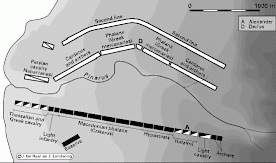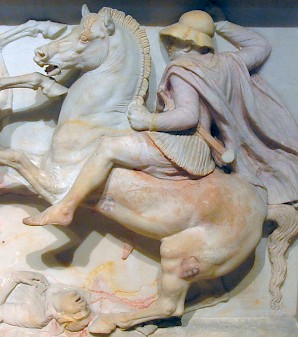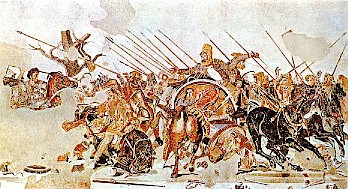Issus (3)
Battle of Issus (5 or 6 November 333 BCE): famous battle during the war between Macedonia and the Persian Empire. The Macedonian king Alexander the Great defeated Darius III Codomannus, won Phoenicia and Egypt, and destroyed the Persian army.
Massacre
Alexander's victorious right wing now swung left towards the center, hard pressed as it was by Darius' Greeks; they forced them back from the river and then, outflanking the broken enemy left, delivered a flank attack on the mercenaries and were soon cutting them to pieces. note

In this way, Alexander attacked the flank of the Persian center. In the meantime, the right wing of the Macedonian army continued the slaughter of the kardakes, who were less heavily armed than the Macedonian soldiers. The only disadvantage for the Macedonians was that they could use their lances only once. However, their swords were equally lethal.
But the fact that their equipment was inferior, was not the only problem of the Persian soldiers; they were unable to retreat, because the light armed in their rear were pushing them forward. When they were killed by the Macedonians, they fell on the ground, and became obstacles to the living. If the Persian soldiers wanted to fight, they needed to step over the bodies and expose themselves to the Macedonian swords; they were killed on top of the other men. The next warrior fell over these two, and in the end, the Macedonians were standing in front of something like a low wall of dead kardakes. Those who were not dead yet, were suffocated under the pressure of the others.

From their side of the macabre parapet, the Persians kept coming, pushed to their death by the people behind them, who did not see what happened at the front. This was not the kind of reinforcement the first line of fighters was waiting for. Only in the foothills, at the extreme left of their array, did the Persians have a chance to survive this bloody mêlée, but here, the Macedonian archers, who were standing a bit higher, were terrible opponents. The massacre may have lasted about a quarter of an hour, and hundreds, even thousands of men were killed. After this, the Persian army no longer had a left wing.
The fight in the center
As already indicated, the Macedonian Companions had moved to the left and was attacking Darius' Greek mercenaries. This removed the pressure from the Macedonian phalanx, which refound its energy and started to move forward again over the blood-soaked soil. The Greeks fought bravely for their employer - someone hit Alexander's thigh - but they were killed one by one. Others took their places, but there were heaps of dead bodies here as well.
The Persian Oxyathres was the brother of Darius and a man highly praised for his fighting qualities; when he saw Alexander riding at Darius and feared that he would not be checked, he was seized with the desire to share his brother's fate. Ordering the best of the horsemen in his company to follow him, he threw himself with them again Alexander, thinking that the this demonstration of brotherly love would bring him high renown among the Persians. He took up the fight directly in front of Darius's chariot and there engaging the enemy skilfully and with a stout heart slew many of them. The fighting qualities of Alexander's group were superior, however, and quickly many bodies lay piled high about the chariot.note

For a moment, the two kings looked into each other's eyes. This is the scene represented on the famous Alexander Mosaic from Pompeii. This work of art, however, suggests that the king of kings panicked and wanted to flee, and that his charioteer tried to turn around. Diodorus suggests that something else happened:
The horses which were harnessed to the yoke of Darius's chariot were covered with wounds and terrified by the piles of dead about them. They refused to answer to their bridles, and came close to carrying off Darius into the midst of the enemy, but the king himself, in extreme peril, caught up the reins, being forced to throw away the dignity of his position and to violate the ancient custom of the Persian kings.{Diodorus, World History, 17.34.6; tr. C. Bradford Welles.}}
According to Diodorus, Darius wanted to use a second chariot, which suggests that he did not want to abandon the fight. The other sources, however, suggest that the king of kings merely rode away on a horse. When Nabarzanes saw that his king left the field, he ordered the retreat of his successful cavalry.
The fight had, by now, lasted for about half an hour, and the Macedonians were advancing everywhere. The soldiers of the right wing of the Macedonian phalanx climbed across the dead bodies and moved to the north, more to secure a part of the field than because there was an organized enemy. On the other wing, the regrouped Thessalian riders and the allied cavalry pursued the Persian cavalry. Some of the horsemen in the Persian army wore heavy lamellar mail, got stuck in the muddy river, and were mercilessly cut down, or drowned. The rest of Nabarzanes' men followed their king, and trampled down their comrades.
The Greek and Thessalian cavalry did not pursue their numerous adversaries very far, but winged to the right, to attack the unprotected flank of the Greek mercenaries, who now had to defend themselves against two Macedonian wings and the phalanx. The massacre continued until sunset and there were no survivors, except for a battalion that managed to break through the Macedonian phalanx, reached the southern bank, and escaped.
Alexander and the other horsemen, chasing their enemies, killed hundreds of fleeing Persians. According to the lowest estimate in an ancient source, the Alexander Romance, about twenty thousand Persians died, and that must be more or less correct. More people could have been killed, but the sun was setting; moonlight was sufficient to continue the killing near the river, but the pursuit was broken off some two hours after the beginning of the battle of Issus.
After the fight
The Macedonian soldiers now occupied the Persian camp with the royal pavilion. Several members of Darius' family, including his wife, mother, daughters, and son, were captured (more...). Only the many wounded did not share in the joy of the Macedonians after the battle. The physicians were working hard. By the light of the moon and torches, they performed dozens of operations.
Those who were wounded by a Persian sword, had a fair chance that the damage would not be more than a scar, which could be shown to the children and grandchildren, with a good story to tell. Fractures could, usually, be treated with splints. Only soldiers with a skull base fracture would suffer; they were the real victims, together with those who had been wounded by spears or arrows. Often, the points of these missiles were dirty - archers placed their arrows in front of them in the soil - and the wounds were consequently infected. Wound fever and tetanus could only be treated by cutting off a leg or arm. Although the physicians made their patients bite on little pieces of wood, there must have been a constant shouting and wailing. Finally, soldiers who were wounded in their belly, suffered from an acute peritonitis and blood poisoning. They suffered terribly and did not dare to move or even breathe: still, they had to vomit, which caused so much pain that they got into a shock, lost consciousness, and died.
The night also took away the Persian wounded. Some of them bled to dead, others died from the cold. For them, there were no physicians or people who assisted them in their final moments.
The day after
When the sun returned, the field was covered with dead bodies - food for dogs and birds. Some of the Macedonians tried to catch the horses that were straying across the field; others stripped the dead bodies from their panoplies, weapons, and possessions; and Alexander looked at the chariot of Darius, in which he had left behind his mantle and bow:
Around Darius' chariot lay his most famous generals who had succumbed to a glorious death before the eyes of their king, and who now all lay face-down where they had fallen fighting, their wounds on the front of their body. Among them could be recognized Atizyes, Rheomithres and Sabaces, satrap of Egypt -all generals of mighty armies- and heaped around these were a crowd of lesser-known infantrymen and cavalrymen.note
Curtius Rufus also tells that, except for about 4,500 wounded, 150 Macedonians were killed in action, and 302 were missing. This means that the army had lost about one tenth of its strength. "Issus" had been a hard fought victory.
The second part of the day was devoted to various affairs. The soldiers were paid, the wounded were treated, the bodies of the Persians further stripped of whatever was useful, the booty divided. Some troops marched to the camp beyond the Pillar of Yunus, where the train had been left. Parmenion took almost all cavalry with him and embarked on a lightning raid on Damascus, the capital of the satrapy of Syria, some 350 kilometer to the south. And finally, the soldiers will have been amused to see dromedaries and the luxuries of the Persian court.
Consequences
For Alexander himself, this victory was of great importance. Unlike the battle at the Granicus, which had been a pretty easy victory, this was his personal triumph: he had led the decisive charge. Until then, it could be said that he owed everything to the capable Parmenion, but from now on, there was no doubt that he was the one in charge of the war. More than ever before, he was king.

And that was something he started to show. Before 333, there are no texts from the Greek world that refer to a Macedonian ruler who calls himself king. On his coins and inscriptions, Philip used only his name. After Issus, Alexander insisted on the use of his royal titulary.
Darius had to call him king too. In December 333, the ruler of Persia proposed negotiations, offering him an alliance and a very large ransom for his relatives. Alexander replied with the usual invectives, several particularly ill-suited remarks about Xerxes' invasion of Greece (in which the Macedonians had been Persian allies), the accusation that the Persians had ordered the assassination of Philip, complaints about Persian intervention in Perinthus, and the suggestion to start accepting Alexander as "king of Asia".
Darius understood that he had to build a new army, which he did with an amazing speed. Less than two years later, he was to lead this new force to battle at Gaugamela, but because most soldiers were recruits, they ran away. The battle of Issus had been decisive. For the time being, however, the Macedonian gains consisted of Phoenicia and Egypt, which were more or less unprotected. Only Tyre and Gaza were to offer resistance.